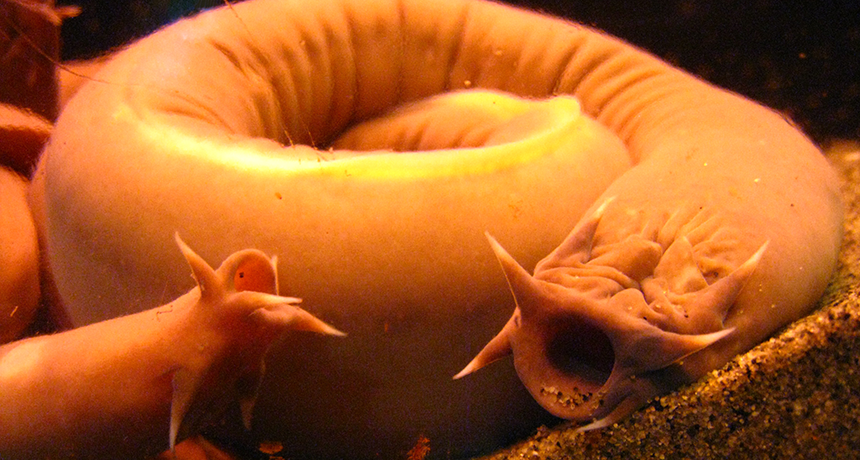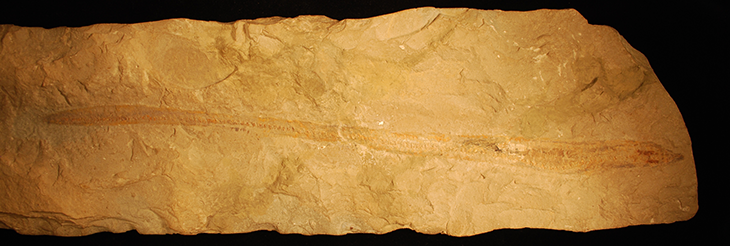A new fossil shows how hagfish went back to basics
The find alters our view of fish evolution

Hagfish (two shown) are unlike most fish. They don’t have eyes, jaws or bones. Now, a newly discovered fossil helps explain how these fish got their unusual look.
SqueakyMarmot/Flickr (CC BY-SA 2.0)
By Riley Black
Hagfish certainly seem prehistoric. Unlike most fish today, these eel-like creatures don’t have jaws, eyes or bones. About the length of a kid’s arm, they make a lot of slime too. Researchers had thought that these strange fish were a throwback to a time before fish evolved jaws and other modern traits. But a stunning new fossil hints that hagfish are not so ancient after all.
Figuring out how hagfish are related to other types of fish has been a challenge. Besides lacking jaws, hagfish do not have a complete spine or true bones. Extinct fish from earlier in life’s history had a similar look. So some scientists thought hagfish were survivors from this branch of the fish family tree. But they weren’t sure because few hagfish fossils had turned up.
Now, a new-found fossil hagfish helps solve the mystery. It came from 100-million-year-old rocks in Lebanon, a nation in the Middle East. Paleontologist Tetsuto Miyashita works at the University of Chicago, in Illinois. He and his colleagues described the fish, February 5, in the Proceedings of the National Academy of Sciences.
The fossil shows the fish’s whole body. Paleontologists named it Tethymyxine tapirostrum. Tethymyxine means “slimy fish from the Tethys.” That’s the name of the ancient ocean the fish swam in. The name tapirostrum combines the words for “tapir” and “snout.” It’s a nod to the fish’s long nose.

A rare find
Hagfish have left behind few fossils because their bodies are so soft. That means they do not fossilize well. “A hagfish is like a swimming sausage,” notes Miyashita. When scientists come across hagfish fossils, they can look confusing. “If you find a fossil fish that looks a bit like a worm, or a fossil worm that looks a bit like a fish, it has a chance of being a hagfish,” he says.
Paleontologist Lauren Sallan agrees that his team’s discovery is surprising. “It’s difficult to find hagfish fossils because they do not have bones or other hard parts,” says Sallan, who works at the University of Pennsylvania in Philadelphia.
But delicate details of Tethymyxine suggest it truly is a hagfish. Some of its organs were preserved in stone. And scientists even found slime glands. That means Tethymyxine made slippery goo to ward off predators, just as today’s hagfish do.
If you bite a hagfish, Miyashita says, “within a second your mouth is full of snot-like goo, and the goo goes down the throat and makes you choke.”
Branching off
The fossil’s resemblance to living hagfish is a clue to these slimy seagoers’ origins. Scientists compared Tethymyxine to other types of fish. They found that some traits that make hagfish seem primitive are actually ones that they formed on their own. Hagfish, it seems, are not leftovers from an early stage of fish evolution.
Miyashita notes that hagfish and more familiar fish share an ancestor. This ancestor had bones, eyes and could sense vibrations in the water. Most fish today have these traits; hagfish do not. That means hagfish went down a different evolutionary route than most fish.
Along the way, hagfish shrugged off these traits. They didn’t need backbones — or any bones, Miyashita says. And from their view point, he says, any animal that can’t squirt out buckets of slime to fight off enemies is missing out.
The new findings show hagfish in a new light. “This disproves the older story that hagfish evolved before these features appeared among the ancestors of other fishes and us,” Sallan says.
Hagfish are not a living time capsule of how fish used to be. Instead, they’re unique fish. Fish that found their own way to be super gross. “We thought hagfish were simple,” Miyashita says, “but they turned out to be a step ahead in getting rid of things they didn’t need.”







